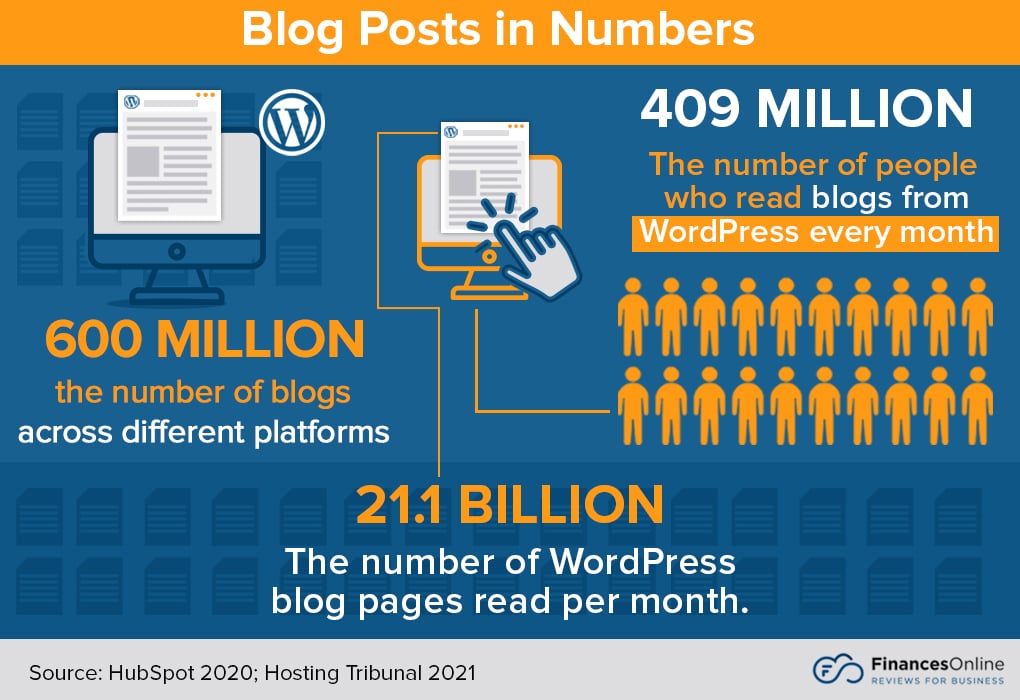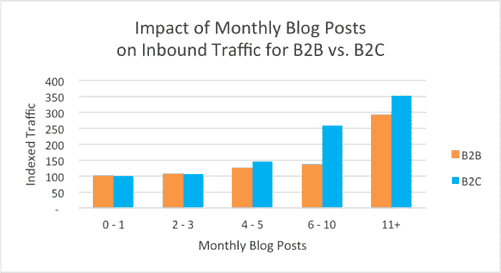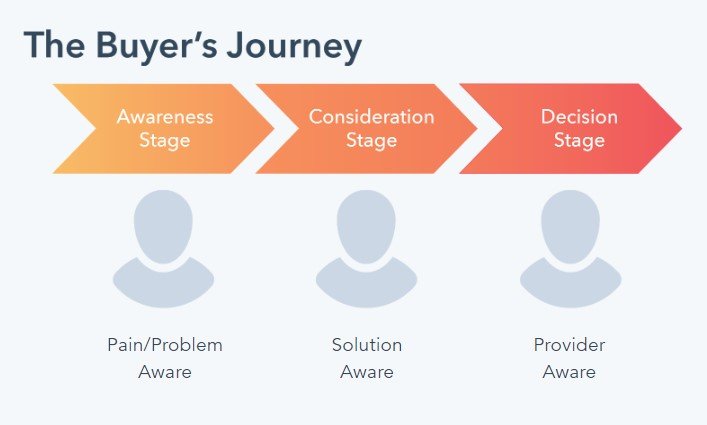
The ROI of Blogging
Blogging emerged in the 90s as a fun way for people to share their thoughts, document their lives, and build community on what was then a brand new medium — the internet. Today, blogs are used by millions of companies of all sizes to drive traffic to their websites, establish their brand expertise, and grow their revenue. The blog ROI your company earns can make a serious impact on your overall business success.
But what does blog ROI really mean? And how do you measure it? In this article, we will:
- Cover the current state of blogging
- Walk through the different types of blog ROI
- Go over how to calculate your blog ROI
Let’s get started!
Quick Takeaways
- More than three-quarters of internet users read blogs regularly.
- Nearly 90% of marketers say blogging is part of their strategy.
- Blog ROI can be found in higher web traffic, more leads and conversions, and established brand awareness and authority.
- Targeting blog content to align with the buyer journey will increase your overall blog ROI.
- To calculate blog ROI, you need to figure out how much revenue you ultimately earn from any given metric you measure.
PS – I put together these 10 tips for optimizing your content marketing. Watch Now!
Blogging: the current state of affairs
A great blog can be the cornerstone of a brand’s content marketing strategy and drive up just about every metric you would measure to determine its success. Blogs are a space where brands can both promote and engage, show their brand personality, establish their expertise, and so much more.
Today there are more than 600 million blogs on the internet and 6 million blog posts are published daily. More than three-quarters (77%) of internet users regularly read blogs and 89% of marketers say blogs are part of their content marketing strategy in some way. Every month more than 20 billion blog pages are visited on WordPress alone.

In 2022, blogs are pretty much an imperative for brands who want to keep up with competitors and stay visible to their audience. And with such a massive potential audience, why wouldn’t a company maintain a blog?
But many don’t! Just over half (54%) of Fortune 500 companies (with all of the resources they need to do it) maintain blogs, and some whole industries lag well behind top blogging industries like lifestyle and technology.
It stumps me personally, but when I tried to think of it from an alternate perspective, I thought that perhaps some companies just aren’t seeing the true potential of blog ROI for their businesses. After all, blogs take time to start seeing results, and if you don’t understand that, it might be easy to dismiss the idea or give up too early.
In the next section, we’ll go over exactly what types of blog ROI brands can expect to earn and why they’re worth working for it, even if it means playing the long game and waiting it out for results in the beginning.
PS – Check out our weekly blog content service to grow your website traffic and leads!
Types of blog ROI for businesses
Website traffic
Higher organic traffic is one of the surest signs your blogging efforts are working. Today, 93% of all online experiences start with a search. Search engines are where people now go to ask questions, research brands and topics, and evaluate potential solutions for their problems. With a great blog that posts frequently, your company can earn 3x the organic traffic than companies that blog sparsely or not at all (this goes for both B2B and B2C companies).

Organic traffic has big cost-benefit impacts for brands who earn it from blogging. Unlike paid ads, which drive traffic only as long as you pay for them, blogs continuously drive organic traffic as long as they’re still published (and especially if you update and repurpose old content).
Visitors that get to your site organically also tend to have a more relevant, meaningful, and authentic experience. They’re on your site because of a true interest or need, not because they saw a paid ad at the top of a Google results page.
Finally, organic traffic methods have endless scalability. Budget constraints cap paid ad potential at a certain point. But once you establish your blog, you can publish as much content as you want, covering new topic pillars, writing for every stage of the buyer journey, and targeting new customer segments whenever it makes sense.
Leads, conversions, and sales
Driving traffic to your website alone is not enough. You need to decide what you want your visitors to do once they get to your site, then implement strategies to get them to take action. Your blog is one of the primary tools you can use to do it.
Start by considering your buyer journey as you develop topics, ideas, and a content plan for your blog. From a very high-level perspective, the buyer journey looks something like this:

Brands can target their blog content to customer segments at each specific stage of the buyer journey. When users see content aligned with where they are on the journey, they’re more likely to take the next step. For example: if someone in the awareness stage finds a case study blog with a call to action asking them to make a purchase, they probably won’t do it. They weren’t ready yet to hear about customers already experiencing the solution, let alone make a purchase themselves.
If, instead, they find a blog post that explains their current problem, then asks for an email address in exchange for a lead magnet with helpful tips, they’re much more likely to take the next step.
This doesn’t mean that that visitor will never make a purchase. But they aren’t ready just yet. For now, you’re establishing brand trust and positioning yourself as the expert by helping them understand the problem and begin to address it on their own.
So, what does this have to do with blog ROI? Well, this type of targeted blog strategy helps you earn more leads, conversions, and sales — the three metrics most directly influential to eventual revenue growth. Hubspot research has shown that brands with blogs earn 67% more leads than those that don’t! But without a targeted, intentional blog strategy, you risk driving organic traffic with no other tangible business results to show for it.
PS – Check out our latest case study that shows how we helped one company double their leads!
Brand Awareness
People love to read blogs — remember, more than three-quarters of internet users read them regularly. Blog articles account for most of the results you’ll find on Google and other search engines, and sometimes people don’t even realize that what they’re reading is actually a blog. In this way, blogs play an impactful role in building brand awareness — in short, the extent to which people recognize and remember your brand.
HubSpot is a great example of this. Many, many marketers and salespeople read HubSpot’s blog whether they’re looking to make a purchase at that moment or not. By publishing frequent, consistent, and valuable blog resources about marketing and sales topics, HubSpot has created massive brand awareness in this space. There’s no doubt that when companies do need solutions, HubSpot is one of the first potential providers they think of.
Brand authority
In addition to building brand awareness, one of the major contributors to blog ROI is established brand authority. Brand authority is important to customers, peers, and search engines — the latter of which uses it as a ranking factor to determine where you’ll appear on results pages. You can build brand authority with your blog in a few ways.
First, covering topics that are relevant to your audience in ways that demonstrate your expertise and knowledge show that your brand can be trusted to provide solutions that work. It helps to build that all-important brand trust, an important contributor to purchase decisions for both B2B and B2C consumers.
Your blog also establishes brand authority by earning backlinks, which occur when other companies link back to your content on their own websites. This established credibility, showing
that other companies in your space trust the knowledge you provide. Backlinks take time to earn, but there are some focused steps you can take that are outlined in the video below from Ahrefs.
Calculating your blog ROI
Now that you know how blog ROI, let’s cover how you can calculate it. The process involves two primary steps:
First, calculate the cost of resources you dedicate to your blog. This includes:
- Salaries for employees who write, manage, and design your blog
- Tools like SEO software and your CMS platform
- Costs for other employees like freelance writers or designers
Then, add up the ROI you’re getting from your efforts. These could be:
- Traffic to your website
- Leads generated
- Subscribers to a newsletter
- Actual sales
- Social media shares
The trick to uncovering true blog ROI is to figure out how these metrics lead to earned revenue. It’s easier in some cases than others. For example, if you generate 100 leads, and 30% of your leads generated convert to actual paying customers, and each paying customer earns you $100 in revenue, your blog ROI from leads would look like this:
(100 leads x .30) x $100 = $3000 in earned revenue from your blog
It’s not always that straightforward a calculation, but you can also use Google Analytics, your CMS platform’s analytics dashboard, and other data tracking strategies to understand how your blog is earning results and estimate what its larger impacts are on your business.
Boost your blog ROI with great content
Publishing frequent, consistent, high-quality blog posts is a time consuming job. If you’re running a business, blogging is something you likely don’t have time to handle on your own. Marketing Insider Group’s team of writers and SEO experts can deliver you optimized, ready-to-publish content every week for one year or more.
Check out our SEO blog writing service to learn more or schedule a quick consultation with me to get started!







Not that easy at all. The elements are all there, but putting a number on them is pretty tough. How many people who land on a blog post, then go to a sales page, then fill in a query form on that page? I suspect I would need to hire an entire analytics team to try to figure that one out.
Oh we love talking about attribution David! I don;t think the buyer journey is ever that linear. The buyer journey for most of our leads is something like:
1. Saw you speak 5 years ago
2. Read an aticle
3. connected on LinkedIn
4. Read another article
5. Downloaded a whitepaper to send to my boss
6. Came to our website once boss approved budget and setup a call